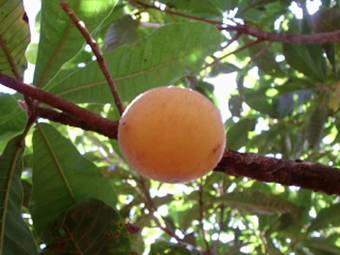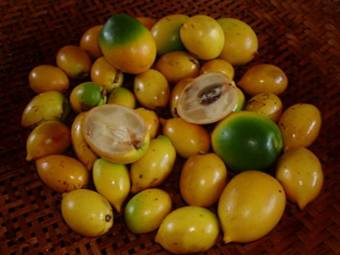POUTERIA BULLATA AND POUTERIA CAIMUTO
POPULAR NAMES: Abiurana, Guapeva (P. bullata) and abiu or caimito (P. caimito)
SAPOTACEAE
|
Abiurana (P. bullata) |
Abiú (P. caimito) |
INDIGENOUS NAME: Abiu comes from the Tupi-Guarani and means "fruit with tip and abiu + rana means "fruit similar to abiu."
Origin: The abiu comes from the Amazonas Forest to Mato Grosso do Norte and on the coast of Pernambuco to Rio de Janeiro. The abiurana already occurs in the southern Atlantic Forest in the semideciduous forest (which loses its leaves at some season of the year) from São Paulo to Paraná, appearing also in the Cerrado de Minas Gerais and Sul de Goiás, Brazil.
Characteristics:
The abiu is an evergreen tree, with lactiferous circular trunk dark brown in
color, with rounded crown and simple, with glossy
Planted in the site of Frutas Raras: The abiu was planted in october 2000 and Abiurana was planted in August 2001. The abiruina flourished in 2006 and bear fruit the first time in 2007.
Tips for growing: Both species can be grown in tropical and subtropical climates. They adapt to any altitude and soil, but is necessary to enrich the soil with enough organic matter and mulch as the plant only found in nature in fertile soil and moist. The abiurana is resistant to drought and falling temperatures to -4°C (25°F), while the abiu does not resist the frost with temperatures below 0°C (32°).
Propagation:
Fresh seeds germinate in
Planting:
Can be planted in any
soil, enriched with organic matter and pH around 5.6.
Space 6 x
Cultivating:
Make only pruning of forming, and remove the branches that are poorly formed or
grown into the canopy, allow space between the branches act the
way for penetration of the sun.
Fertilize with
organic compost, can be (
Uses: The fruits are consumed only in-natura. The tree is ornamental.
Flowering in the site of Frutas Raras: Abiurana - November 2006.
Fruiting in the site of Frutas Raras: Abiurana - February 2007.
BUY THE BOOK “COLECIONANDO FRUTAS”
Back to the seedlist (English) or back to Sapotaceae (Portuguese)

